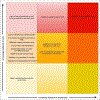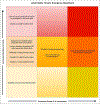Interprofessional In Situ Simulation to Identify Latent Safety Threats for Quality Improvement: A Single-Center Protocol Report
- PMID: 36400572
- PMCID: PMC11221780
- DOI: 10.1016/j.jen.2022.09.007
Interprofessional In Situ Simulation to Identify Latent Safety Threats for Quality Improvement: A Single-Center Protocol Report
Abstract
In situ simulation has frequently been used to improve team performance and provide an opportunity for the practice of critical skills and identify latent safety threats, which are undetected risks that may lead to adverse outcomes. However, the use of known quality improvement tools to prioritize and mitigate these safety threats is an area requiring further study. Over the course of 9 in situ simulations of a pediatric shock case, postcase debriefs were held to identify latent safety threats in an emergency department and a mixed pediatric and adult inpatient unit. Latent safety threats identified included structure-related threats such as inability to locate critical equipment, knowledge-based threats relating to rapid intravenous fluid administration, and communication-based threats such as lack of role designation. Identification of latent safety threats in the health care environment may assist clinician leaders in mitigating risk of patient harm. The protocol described may be adopted and applied to other critical event simulations, with structured debriefing used as a tool to identify and mitigate threats before they affect the patient.
Keywords: Child; Delivery of health care; Emergency service; Hospital communication; Patient harm; Simulation.
Copyright © 2022 Emergency Nurses Association. Published by Elsevier Inc. All rights reserved.
Conflict of interest statement
Author Disclosures
Conflicts of interest: none to report.
Figures


References
-
- Institute of Medicine (US) Committee on Quality of Health Care in America, Kohn LT, Corrigan JM, Donaldson MS. To Err Is Human: Building a Safer Health System. National Academies Press; 2000. - PubMed
-
- Lamberta M, Aghera A. Latent Safety Threat Identification via Medical Simulation. In: StatPearls. StatPearls Publishing; 2022. - PubMed
MeSH terms
Grants and funding
LinkOut - more resources
Full Text Sources

